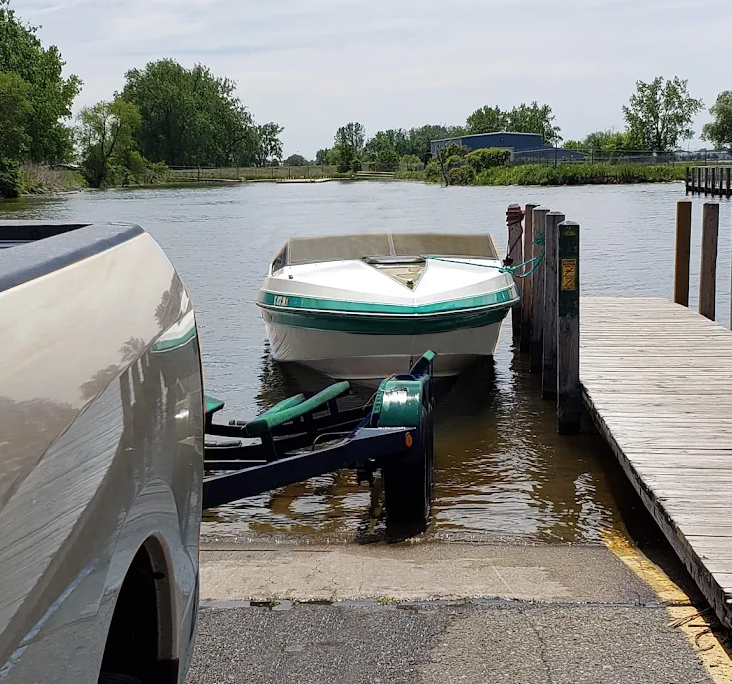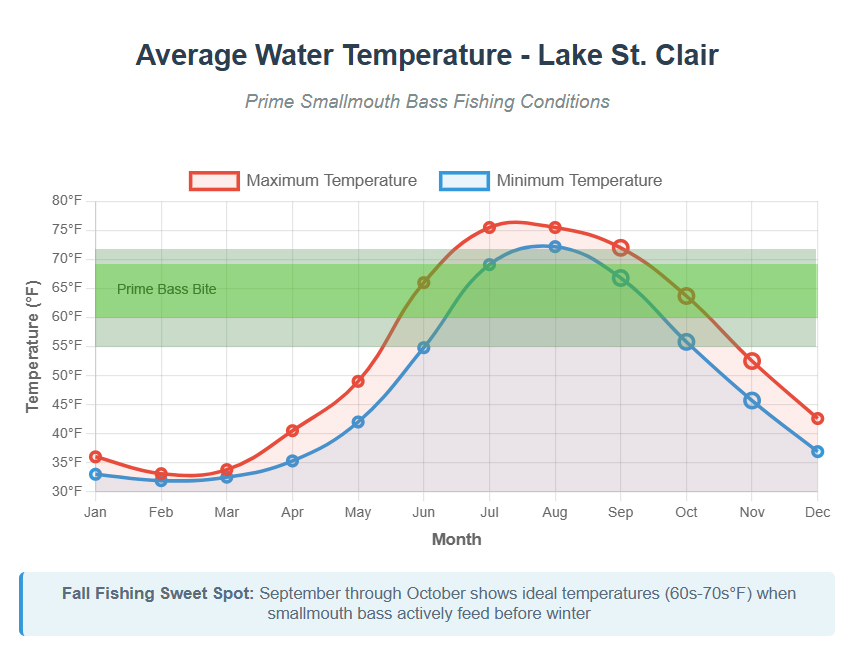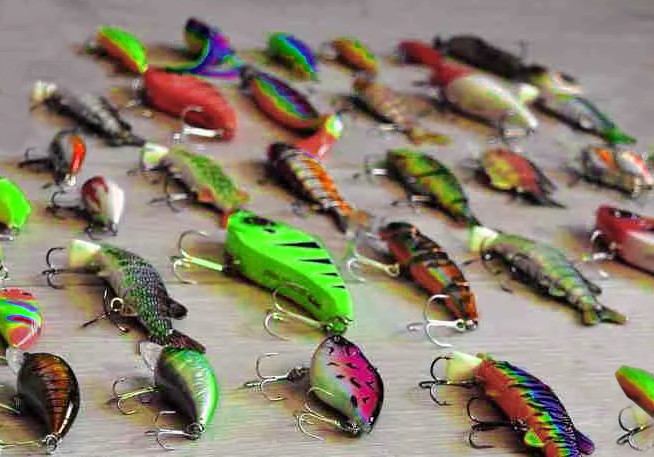
Most every action picture of someone bass fishing is one of a largemouth bass thrashing the surface of a lake with a lure in its jaw. When people think "bass action," largemouths naturally come to mind. There's another bass that provides amazing action, especially this time of year - smallmouth bass!
People from states all across this nation travel to Michigan to fish Lake St. Clair for its smallmouths. The lake is perfect for this fish and there's plenty of room for everyone.
Lake St. Clair sits between Lake Huron and Lake Erie, receiving water from the St. Clair River and draining into the Detroit River. It's a world-class fishery that provides fairly shallow waters, perfect vegetation and cover, and good clarity. The smallmouth bass are just waiting to be caught!
I like to target Anchor Bay as it holds plenty of fish and has easy access. The locals suggested fishing near several of the higher numbered east - west roads that run along the northern shoreline, commonly called the "Mile Roads" because they're numbered by distance from Detroit. These roads aren't official fishing zones, but they provide easy access points and serve as familiar reference points for anglers.
Public access boat launches in this area include Selfridge, Brandenburg Park, Fair Haven, and Harley Ensign.

I put my boat in at the Selfridge DNR launch and was marking fish within minutes.
Drifting along rocky points, break lines, and weed edges near these areas quickly produced results. Within ten minutes, my first fish hit - a solid smallmouth that bulldogged down, ran sideways, and put my spinning rod to the test. By the time I slid the fish into the net, I had a 3-pound smallmouth on the boat, a respectable fish for St. Clair but not unusual for this fishery.

Why Lake St. Clair?
The lake is unique. At only about 430 square miles, it's relatively small compared to the Great Lakes it connects, yet it holds an incredible density of smallmouth bass.
The shallow depth (averaging around 11 feet) combined with abundant forage - perch, gobies, crayfish, and minnows - creates a factory for producing thick, strong fish. The water clarity is usually excellent, so anglers can sight-fish or at least spot the changes in bottom composition that attract bass.
It's no secret, either. Bass tournaments from across the country stop here, and it's not unusual to see boats from Ohio, Indiana, Illinois, or even Kentucky making the trip north. Still, the lake is big enough that you can find your own water, especially if you're willing to launch from one of the many DNR sites scattered along both the Michigan and Ontario shorelines.

Timing the Bite
Fall is a prime time for smallmouths. As water temperatures slide down into the 60s, the fish put on the feed bag, fattening up before winter.
Unlike largemouths that sometimes get sluggish in cooler water, smallmouths thrive. They'll chase down a bait with reckless abandon, and they don't seem to care if the wind is rolling whitecaps across the surface.
On my September trip, I found schools stacked along rocky points and inside turns near weed edges. Drifting with the wind while dragging a tube jig seemed to be the ticket. Every few minutes, my rod would load up and another bronze-back would come leaping out of the water, shaking its head and testing my knot strength.
Weather is always part of the equation on Lake St. Clair. Fall often brings crisp mornings, steady winds, and the occasional fast-moving front. A calm day makes for easy drifting and spotting bottom transitions, but don't shy away from a chop---smallmouths often bite best when waves stir things up. Just keep an eye on the forecast, as the shallow basin can get rough in a hurry.

Productive Presentations
Lake St. Clair smallmouths can be caught with a variety of methods. Here are a few that consistently produce:
1. Tube Jigs
The standard presentation, and for good reason. A 3.5--4" tube rigged on a ¼--⅜ oz. jig head mimics the crayfish that smallmouths love. Colors like green pumpkin, watermelon, and brown with copper flake work well. Drag or hop them along bottom transitions.
2. Drop-Shot Rigs
Because of the lake's clarity, finesse presentations shine. Nose-hook a goby- or shad-imitating soft plastic above a drop-shot weight and let it flutter in place. Great for when the bite slows or fish are holding just off bottom.
3. Crankbaits and Jerkbaits
On windy days, when fish are more aggressive, casting crankbaits that dive 6--10 feet can cover water quickly. Suspending a jerkbait in silver or perch patterns can draw violent strikes.
4. Spinnerbaits and Swimbaits
In vegetation or around wind-blown flats, a spinnerbait or a paddletail swimbait can draw reaction bites. White or chartreuse often gets noticed in stained water, while natural colors excel in clear conditions.
5. Live Bait
For anglers who prefer live bait, minnows and crayfish drifted along the breaks are deadly. Just be prepared: smallmouths here aren't shy, and they'll inhale bait with gusto.
Finding Fish
Electronics help, but on St. Clair you can often use your eyes. Look for subtle color changes that indicate bottom transitions from sand to gravel or from rock to weed. Smallmouths love those edges. Anchor Bay on the north end is another hotspot, and the Canadian side can also hold nice fish if you have the proper license.
The Detroit River can also be outstanding in fall, with fish stacking up in current seams as they transition between lakes. This is more advanced fishing, requiring careful boat control in moving water, but the rewards can be incredible.
Gear Checklist for Lake St. Clair Smallmouths
Rods: Medium-light to medium spinning rods (6'6"—7') for finesse; medium baitcasting rods for crankbaits.
Reels: 2500—3000 size spinning reels with smooth drag.
Line: 8—10 lb braid with 8—12 lb fluorocarbon leader.
Terminal Tackle: Tube jig heads (¼—⅜ oz.), drop-shot weights (⅛—¼ oz.), 1/0 drop-shot hooks.
Electronics: Fish finder with GPS; helpful for following breaklines and finding subtle edges.
Safety: Good life jacket (required), Canadian license (if crossing), and a weather app - St. Clair can get rough fast.
Tackle Considerations
Smallmouths fight differently than largemouths. They don't just surge into cover - they pull hard, run long, and leap high. Because of this, medium-light to medium spinning gear spooled with 8--10 lb braid and a fluorocarbon leader is ideal for finesse presentations.
For crankbaits and reaction baits, a medium baitcasting rod with 10--12 lb. fluorocarbon works well.
One critical tip: check your knots often. These fish don't quit, and they'll test every weak spot in your setup. Retie frequently, especially after boating a few fish.
Regulations and Access
Michigan requires a fishing license for anyone 17 or older. If you plan to cross into Canadian waters, you'll need an Ontario license and to follow Canadian regulations. Border patrols are active on this water, and fines for crossing without proper credentials can ruin a trip quickly.
Launch ramps are plentiful. Besides Selfridge, there are DNR sites at Harley Ensign, Fair Haven, and Brandenburg Park. Many private marinas also allow launches for a fee. Weekends can be busy, but the lake's size disperses traffic quickly.
A World-Class Fishery
On that first drift from Selfridge, I caught and released six smallmouths in under an hour. Not one was under 2 pounds, and the biggest probably pushed past 5. That's the magic of St. Clair - you don't just hope for a quality fish; you expect it.
I've fished plenty of waters where a 3-pound bass is a banner day. Many times here, it's just another cast.

Lake St. Clair isn't about luck - it's about abundance, energy, and the kind of action that keeps anglers driving across state lines to experience it. If you haven't experienced it yourself yet, fall is the time to see why this lake is on every serious bass angler's bucket list.
As I tied down my dripping boat to the trailer, I thought back to all those iconic pictures of largemouths and laughed.
Yes, largemouths are fun.
But if you want true "bass action," the kind where every cast could connect with the fish of a lifetime (or a Master Angler award,) fishing for smallmouth bass on Lake St. Clair in the fall is hard to beat.